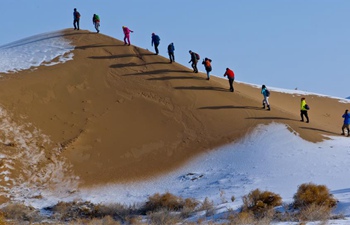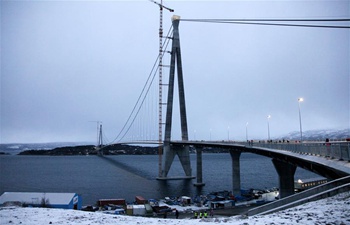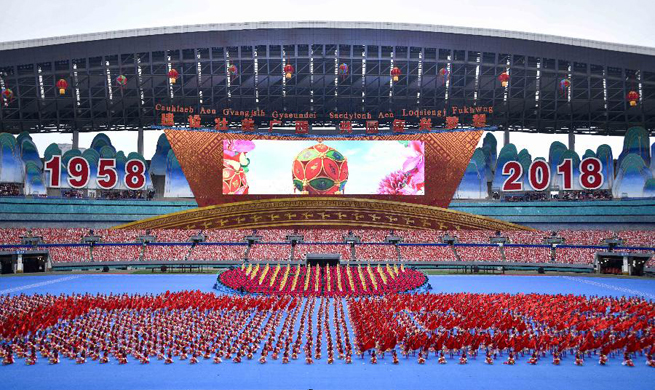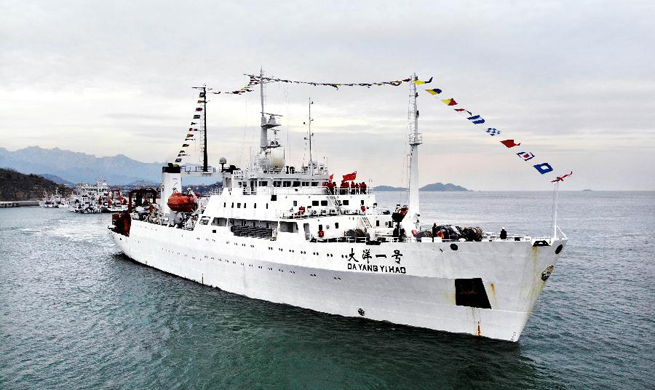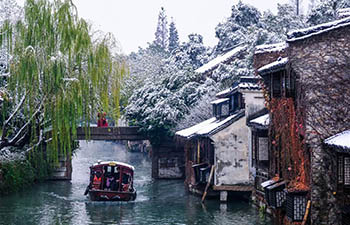by Prithvi Shrestha
KATHMANDU, Dec. 11 (Xinhua) -- Nepal's massive trade deficit as of first four months of the current fiscal year that began in mid-July has not worried Nepali Finance Minister Yubaraj Khatiwada.
"Let's not see the trade deficit in number alone. Let's also see what types of goods we are importing," Minister Khatiwada said while addressing a function organized by a grouping of Nepal's economic journalists last weekend.
This Himalayan country's deficit expanded by 40.3 percent to 454.47 billion Nepali Rupees (4 billion U.S. dollars) during the first four months, according to Trade and Export Promotion Centre (TEPC), a trade promotion body under Nepal's Commerce Ministry.
It is the result of importing goods worth 483.75 billion Nepali Rupees (4.27 billion U.S. dollars) against exports of just 29.28 billion Nepali Rupees (26 million U.S. dollars).
Amid a ballooning trade deficit, Nepal faced a balance of payment deficit of 316.2 million U.S. dollars in the first three months of the current fiscal year.
Foreign exchange reserves also declined by 5.2 percent to 9.56 billion U.S. dollars despite a surge in remittances, Nepal's main source of financing imports, according to Nepal's central bank.
"Trade deficit has grown because we have bought commercial planes. But, we need planes to bring more tourists to Nepal. We plan to develop 10,000 megawatt hydropower projects in the next 10 years. For this, we have to import two thirds of the total materials needed to develop the hydro projects. They may contribute to the trade deficit but the country will benefit in the long run," said the minister.
TEPC data supports his assertion. During the first four months of the current fiscal year, iron and steel products and machineries occupied the second and third position after fuel, which has long topped the chart of imports.
There has also been a surge in imports of raw materials of industries such as crude soya bean oil, palm oil, cotton and wool, according to TEPC data.
Nepali economists said the huge portion of imports like construction materials and raw materials suggest that industrial production and construction activities are picking up in the country.
"The import of industrial raw materials and construction materials are obviously a good sign for the Nepali economy as it shows investment in Nepal has been growing and the economy has become dynamic," Shankar Sharma, a senior economist, told Xinhua recently.
He also gave credit to the stable political environment after last year's elections in Nepal as it helped in boosting business confidence. The country now has the elected governments at the center, provinces and at the local levels.
The import of industrial raw materials and capital goods contributed to Nepal's overall imports even in the last fiscal year 2017-18.
"The import of industrial supplies and capital goods drove the overall import growth due to ongoing post earthquake reconstruction, increased infrastructure investment and an uptick in industrial activity, the World Bank said in its 'Nepal Development Update' released last month.
This in turn led to the global lender to conclude that Nepal is moving forward to investment-driven economic growth from consumption-driven growth fueled by remittance, in its report.
"Gross investment is expected to drive expansion as the Nepali government has emphasized engaging the private sector and raising low level of Foreign Direct Investment (FDI), it said. Currently, FDI is less than one percent of Gross Domestic Product in Nepal, according to the report.
As Nepal aims to become a middle income country by 2030, a shift from remittance-led and consumption-based growth, to one that is driven by investment and production is a must, the report has pointed out.
Nepali economists however caution whether Nepal has already entered the phase where the economy is being driven by investment.
"We have to see whether the economy would grow by at least 5-6 percent in the next few years because the modest growth rate seen in the last two fiscal years is also due to good monsoon and post-earthquake reconstruction activities," said Sharma.
Nepal is aiming at a growth rate of eight percent in the current fiscal year as the Nepali government declaring the current fiscal year as the foundation year for the history of economic prosperity.
Nepal's economy had grown by 5.9 percent in the last fiscal year, down from the previous fiscal year's rate of 6.9 percent.
There is also reason to be optimistic as the Himalayan country ended the chronic problems of load shedding and labor unrest contributing to creating a conducive environment for investment. Nepal has seen a surge in investment commitments from domestic and foreign investors lately.
In the last fiscal year, Nepal saw total investment commitment doubled to 3.1 billion U.S. dollars from the previous fiscal year's 1.44 billion U.S. dollars, according to Nepal's Department of Industry, a government body which registers industries.
However, Nepali economists said the ongoing liquidity crunch in the banking system for nearly two months might affect both investment and growth. Excessive lending in the first quarter of the current fiscal year against poor deposit collection, has contributed to a lack of funds which can be given as credit to the borrowers, according to the bankers.
Since mid-July, deposits in the commercial banks grew by 3.78 percent while lending surged by 7.7 percent, according to Nepal Bankers' Association, the grouping of Nepal's commercial banks. This led to credit expansion close to the regulatory limit set by the Nepal Rastra Bank (NRB), the central bank of the Himalayan country.
Nepali banks are saying that they are making selected lending despite high demand for loans lately.
"Unavailability of loans as desired from the banks and a hike in the interest rate caused by the liquidity crunch might discourage investment," Ram Prasad Gyawali, former head of Central Department of Economics at Tribhuvan University, Nepal, told Xinhua.
"This will also ultimately hit the prospect of economic growth."
On the other hand, the economists have also pointed out whether Nepal could sustain massive growth in imports of both capital goods and consumer goods as the remittance might be affected in the future due to declining numbers of Nepali migrant workers.
Nepali workers going abroad for employment decreased by 36.7 percent in the first three months of the current fiscal year, while their number had declined by 10.1 percent in the last fiscal year.
For investment-led growth in the long run, the World Bank has suggested introducing a number of reform measures.
It suggested for improving the competitiveness of the private sector and integrating with global markets, strengthening the financial sector through the development of long-term financing instruments and strengthening the framework for infrastructure finance, including the public private partnership.




